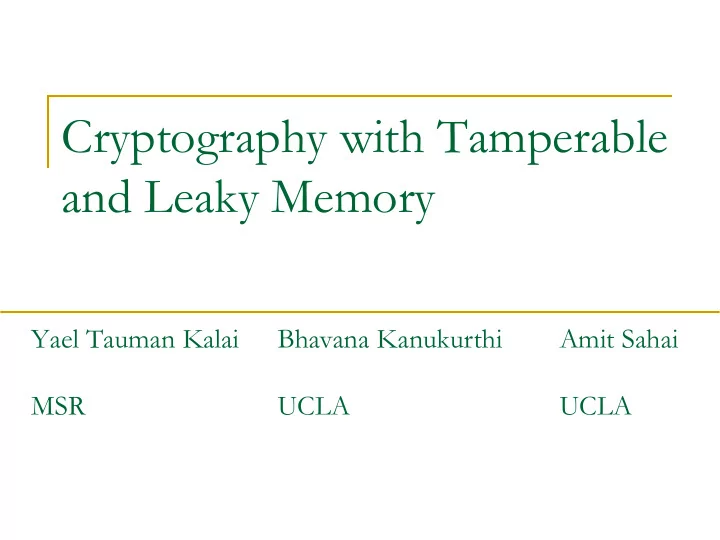

Cryptography with Tamperable and Leaky Memory Yael Tauman Kalai Bhavana Kanukurthi Amit Sahai MSR UCLA UCLA
Leakage Resilient Cryptography [Rivest1997, Boyko1999, Canetti-Dodis-Halevi-Kushilevitz-Sahai2000, Ishai-Sahai-Wagner2003, Micali- Reyzin2004, Ishai-Prabhakaran-Sahai-Wagner2006, Dziembowski-Pietrzak2008, Pietrzak2009 , Akavia- Goldwasser-Vaikuntanathan2009, Dodis-Kalai-Lovett2009, Naor-Segev2009, Katz-Vaikuntanathan2009, Alwen-Dodis-Wichs2009, Alwen-Dodis-Naor-Segev-Walfish-Wichs2009, Faust-Kiltz-Pietrzak-Rothblum2009, Faust-Rabin-Reyzin-Tromer-Vaikuntanathan2010, Dodis-Goldwasser-Kalai-Peikert-Vaikuntanathan2010, Goldwasser-Kalai-Peikert-Vaikuntanathan2010, Juma-Vahlis2010, Goldwasswer-Rothblum2010, Canetti- Kalai-Mayank-Wichs2010, Dodis-Haralambiev-LopezAlt-Wichs2010, Brakerski-Kalai-Katz- Vaikuntanathan2010, Boyle-Segev-Wichs2010, Dodis-Pietrzak2010, Braverman-Hassidim-K2010, Lewko- Waters2010, Lewko-Rouselakis-Waters2011, Lewko-Lewko-Waters2011] We know how to build cryptographic scheme that are secure against continual leakage! [Dodis-Haralambiev-LopezAlt-Wichs2010, Brakerski-Kalai-Katz-Vaikuntanathan2010] BUT physicals attacks aren’t restricted to leakage attacks; they also tamper with the memory! [Considered for e.g., in Biham and Shamir Crypto ’97; Boneh -DeMillo- Lipton Eurocrypt ‘97, Kocher - Jaffe- Jun Crypto ’99, Govindavajhala and Appel IEEE Symposium on S&P ’03] 2
Prior Work: Tamper Resilient Cryptography [Gennaro, Lysysanskaya, Malkin, Micali, Rabin TCC ’04]: Achieve strong tamper – proof security but rely on some non – tamperable (user – specific) memory. [Ishai, Prabhakaran, Sahai, Wagner Eurocrypt ’06]: Considered tampering applied to all parts of computation. But consider only tampering functions that set/reset bits. [Bellare, Kohno Eurocrypt ’03], [Dziembowski, Pietrzak, Wichs, ICS ‘10], [Applebaum, Harnik, Ishai ICS ‘11] Limited tampering to memory. 3
Our Goals Build leakage and tamper resilient that always satisfy the following conditions: All user – modifiable memory is tamperable and leaky ; (in particular, the public key stored on device is also tamperable). Note that public/private keys must be part of user-modifiable memory, since they are unique to each user. Allow for arbitrary tampering and leakage. We achieve this! But …. Assume non – tamperable public parameters (CRS). Rely on a source of true local randomness. (Necessary for our setting: Lysysanskaya, Liu SCN ‘10) 4
Our Results (Informally) Result 1: We present a general transformation that converts any scheme resilient to bounded leakage into one that is also resilient to continual tampering. (Instantiable using FHE + NIZKs.) Result 2: We construct encryption and signature schemes resilient to continual leakage and tampering, based on linear assumptions over bilinear groups. 5
Signature Scheme in the Continual Tampering Model PK CIRCUIT SELF – T 1 DESTRUCTS!!** T 2 ( T 1 ( SK )) sign m T 1 ( SK ) SK σ **under certain T 2 conditions Forgery Success: if forgery verifies wrt original PK Easy to see: This is impossible to achieve! Problem: Adversary can tamper with sk bit-by-bit and use her signature queries to learn the entire secret key! FIX: Need to assume that the circuit self – destructs! 6
Building Block: NIZK Proofs of Knowledge Common Reference String (CRS) Goal: Prove statement X in L Verifier Prover π = P ( CRS, x, w ) witness ( w ) We require our NIZK proof system to have some additional properties: Simulation soundness: Hard to prove false statements even after seeing simulated proofs of false statements. Proof of Knowledge: If adversary outputs a valid proof, then the simulator can extract a witness out of it. SHORT proof: Length of π should depend polynomially on | w |. 7
Our General Transformation S = (Gen, Sig, Ver) is a leakage resilient signature scheme with sk ← {0,1} n and pk efficiently generated from sk S’ = (Gen’, Sig’, Ver’) is the tamper resilient scheme we build from S. Gen’: • Sets sk : PRG( r ) “short” simulation sound • sk ′:= ( sk , π ) (where π : NIZK proof of pseudo – randomness) proof of knowledge Sig’ sk’ ( m ) : First verifies sk ′:= ( sk , π ) is valid (self – destructs otherwise). Returns Sig sk ( m ) 8
Informal Theorem: If S is resilient to | r | + | π | bits of leakage, then S ’ is resilient to continual tampering; (where r: PRG seed; π : NIZK proof of pseudo – randomness). 9
Intuition behind Security pk pk, crs Leakage Leakage Tampering Challenger C Adversary B Adversary A ( crs, with trapdoor μ ) ( sk, pk ) where sk← {0,1} n Sign m Sign m Sig and Sig’ are equivalent until the σ σ secret key has been T amper T (to be applied tampered with! Leakage L ( to be on (( sk , π ), pk )) applied on ( sk, pk )) L ( sk, pk ): With ( r*, π * ) , B has Computes π := SimProof that “ sk is pseudo- random”. Extracts r* from ( sk * , π *, pk* ) the current secret state ( i.e., sk*, π * ) Sets ( sk * , π *, pk* ) := T ( sk , π , pk ) . r*, π *, entirely; so she can simulate rest of A’s queries on her own. If proof is valid, then sk* = PRG ( r* ) , so can extract r* 10
Signature Scheme in Continual Tampering and Memory Leakage Model PK L 1 L 2 Bounded L 1 ( SK 1 ) L 2 ( SK 1 ) amount of leakage T 1 sign m T 1 ( SK 1 ) SK 1 SK 2 Starting Point for our work: σ Continual Memory Leakage Scheme of BKKV UPDATE SK 2 = Update ( T 1 ( SK 1 ) ) More leakage, NOTE: amount of leakage that tampering & the adversary gets in the entire signature queries lifetime of the secret key is not Main Challenge: bounded (in any order) How do you do secure updates with tampered secret keys? Success: if forgery Forgery verifies wrt PK 11
Our Continual Tamper and Leakage Resilient Scheme (NOTE: PP is non-tamperable; but not user specific) See paper for details! 12
Conclusion This talk: Presented a generic transformation that converts bounded leakage resilience to (leakage) and tamper resilience. Presented the first number-theoretic construction of cryptographic schemes simultaneously resilient to continual leakage and tampering. 13
Thank you!!! 14
Recommend
More recommend